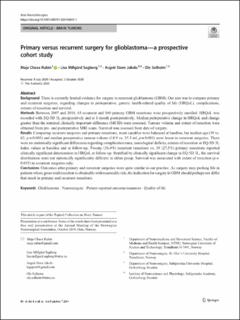| dc.description.abstract | Background: There is currently limited evidence for surgery in recurrent glioblastoma (GBM). Our aim was to compare primary and recurrent surgeries, regarding changes in perioperative, generic health-related quality of life (HRQoL), complications, extents of resection and survival. Methods: Between 2007 and 2018, 65 recurrent and 160 primary GBM resections were prospectively enrolled. HRQoL was recorded with EQ-5D 3L preoperatively and at 1 month postoperatively. Median perioperative change in HRQoL and change greater than the minimal clinically important difference (MCID) were assessed. Tumour volume and extent of resection were obtained from pre- and postoperative MRI scans. Survival was assessed from date of surgery. Results: Comparing recurrent surgeries and primary resections, most variables were balanced at baseline, but median age (59 vs. 62, p = 0.005) and median preoperative tumour volume (14.9 vs. 25.3 ml, p = 0.001) were lower in recurrent surgeries. There were no statistically significant differences regarding complication rates, neurological deficits, extents of resection or EQ-5D 3L index values at baseline and at follow-up. Twenty (36.4%) recurrent resections vs. 39 (27.5%) primary resections reported clinically significant deterioration in HRQoL at follow-up. Stratified by clinically significant change in EQ-5D 3L, the survival distributions were not statistically significantly different in either group. Survival was associated with extent of resection (p = 0.015) in recurrent surgeries only. Conclusions: Outcomes after primary and recurrent surgeries were quite similar in our practice. As surgery may prolong life in patients where gross total resection is obtainable with reasonable risk, the indication for surgery in GBM should perhaps not differ that much in primary and recurrent resections. | en_US |

